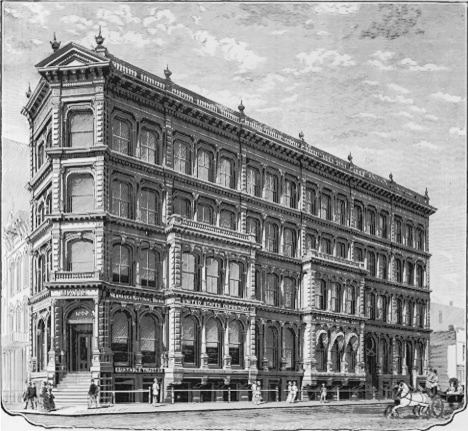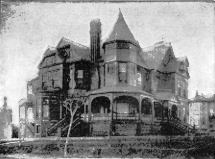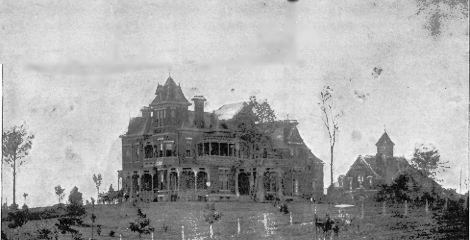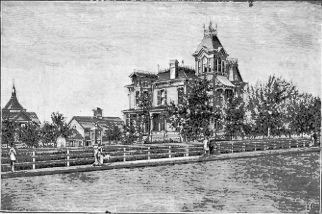|
OMAHA
ILLUSTRATED.
deposit of money, got out of bed, and
with an axe instantly killed his sleeping companion by two
well-directed blows. Securing the keys of the safe, he
easily obtained possession of the money, which he placed in
a tin can and then bid it under the sidewalk in the
immediate vicinity. Returning to the store he set fire to
the building, and when the flames had made considerable
headway he fired a shot into his arm in order to support a
statement that
|
[Dr. Victor H.
Coffman was born September 10, 1839, near
Zanesville, Ohio. At the age of ten years be moved
to Piatt county, Illinois, and thence to Indianola,
Iowa, in 1854. For four years he attended the
University at Mount Pleasant, and in 1858 be
decided to enter the medical profession. He
accordingly began the study of medicine with Dr. C.
W. Davis, at Indianola, and afterwards attended the
Chicago Medical College. The civil war being in
progress, he entered the service of the Union army
as Assistant Surgeon of the
|
|
Thirty-fourth Iowa Infantry, August 22nd, 1862,
and in 1863 he was promoted to be Surgeon of the
regiment. He was Division Surgeon with the late
Major General Steel, and also with Major General C.
C. Andrews, with whom he was always on the most
intimate terms. He was highly appreciated by these
superior officers. Dr. Coffman was the chief of the
operating staff at Vicksburg, Mobile, and on the
celebrated Red River expedition. During the siege
of Mobile in 1864, be distinguished himself and was
brevetted Lieutenant-Colonel of volunteers, for
meritorious services. He served also on the Texas
coast with General Ransom and Captain Dickey, by
whom he was highly complimented. In Ingersoll's
history of the Iowa troops, Dr. Coffman receives
marked mention. The historian, reflecting the
sentiment of the officers and soldiers, in relating
the valuable and gallant services of the Doctor
says that "he is one of the
|
DR. VICTOR H. COFFMAN.
|
best of surgeons and of men."He was a great
favorite with the army during his connection with
it. For a brief period following the close of the
war he was on duty with the Seventeenth Infantry,
U. S. A., as Contract Surgeon, at Houston, Texas.
Although having gained valuable surgical experience
in the field, he did not feel content with his
medical knowledge, and he accordingly went to
Philadelphia and there finished his education in
Jefferson Medical College, from which be graduated
in 1866. Dr. Coffman located in Omaha, April 14,
1867, and soon became one of the leading physicians
of Nebraska -- a rank which he has ever since held.
His practice amounting to $25,000 during the year
1887, is by no means limited. He is frequently
called to distant points to perform difficult
surgical operations. He performed the first
operation for ovariotomy in Nebraska, since which
he has had several successful operations. Dr.
|
|
Coffman has the esteem and confidence of the
community, and there is no physician in Omaha who
stands higher in the profession. He was one of the
organizers of the Omaha Medical College, an
institution which has been growing steadily since
its opening in 1881. He was elected in 1881 as
professor of theory and practice, and has ever
since been connected with the college. He is a
member of the American Medical Association and also
of the Nebraska State Society. In the practice of
his profession be has been proverbially kind to the
poor. His books show an indebtedness of
non-collectible bills of over one hundred thousand
dollars during his twenty years' practice in the
city of Omaha. Dr. Coffman has an extensive
personal knowledge of the various States of the
Union, especially as to sanitary conditions, and he
unhesitatingly claims that Nebraska is the
healthiest region of this country, and that Omaha
is the healthiest city on the continent, and that
no epidemics prevail here, and that all diseases
are here amenable to treatment. Dr. Coffman was
married September 10, 1879, in the city of Chicago,
to Miss Rose Devote. They have three children --
Weir D., Augusta Marie, and Rose Lyle -- and reside
in one of the most elegant homes in Omaha, located
on St. Mary's avenue and Twenty-seventh
street.]
|
he intended to make, to the effect that the store had been
burglarized and fired by some unknown party who had shot
him. Throwing the pistol away, he ran out and yelled "Fire!
murder! thieves! "The fire was extinguished and the
butchered body of Higgins found. Suspicion pointed at once
to Baker, whose story was not believed. He was arrested,
tried and convicted. The attorneys for the prosecution were
Hon. G. W. Doane and Hon. John I. Redick. The prisoner was
defended by Col. Savage, Ben Sheiks, Mr. Hopkins and Mr.
Parks. The Supreme Court overruled the motion for a new
trial, and affirmed the sentence
[44]
|
